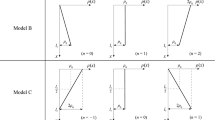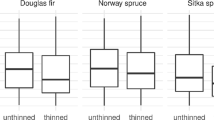Abstract
Natural frequency and damping ratio were measured for nine plantation-grown Douglas-fir (Pseudotsuga menziesii Mirb. Franco) trees from the Oregon Coast Range under different levels of crown removal. Natural frequency of trees, in both their unpruned and completely de-branched states, was linearly related to the ratio of diameter at breast height to total tree height squared (i.e., DBH/H2), as expected from the theory governing the oscillation of a cantilever beam. Pruning resulted in an increase in natural frequency; however, at least 80% of the crown mass needed to be removed before this increase was noticeable. A single equation was developed that enabled the natural frequency of a tree of given size and pruning intensity to be predicted. Damping ratios of unpruned trees varied considerably from 8% to almost critical, while those for completely de-branched trees ranged from 1% to 8%. Two different trends in damping ratio were observed during pruning. Some trees exhibited an increase in damping ratio with initial crown removal, followed by a sharp decrease when the uppermost portion of the crown was removed. Others showed little or no change in damping ratio followed by a sharp reduction upon removal of the uppermost portion of the crown. Damping was mainly due to aerodynamic drag and preventing interference with neighbouring trees had little effect. Theoretical analysis using the finite element method indicated that changes in natural frequency as a result of pruning are not due to changes in damping ratio, but rather changes in mass distribution. This analysis also suggested that treating branches as lumped masses rather than individual cantilevers attached to the main stem may not be appropriate.








Similar content being viewed by others
References
Baker CJ (1995) The development of a theoretical model for the windthrow of plants. J Theor Biol 175:355–375
Clough RW, Penzien J (1993) Dynamics of structures. McGraw Hill, New York
Everham EM (1995) A comparison of methods for quantifying catastrophic wind damage to forests. In: Coutts MP, Grace J (eds) Wind and trees. Cambridge University Press, Cambridge, pp 340–357
Flesch TK, Wilson JD (1999) Wind and remnant tree sway in forest cutblocks. II. Relating measured tree sway to wind statistics. Agric For Meteorol 93:243–258
Gardiner BA (1989) Mechanical characteristics of Sitka spruce. Forestry Commission Occasional Paper 24. Forestry Commission, Edinburgh
Gardiner BA (1992) Mathematical modelling of the static and dynamic characteristics of plantation trees. In: Franke J, Roeder A (eds) Mathematical modelling of forest ecosystems. Sauerländer, Frankfurt/Main, pp 40–61
Gardiner BA (1995) The interactions of wind and tree movement in forest canopies. In: Coutts MP, Grace J (eds) Wind and trees. Cambridge University Press, Cambridge, pp 41–59
Gardiner BA, Stacey GR, Belcher RE, Wood CJ (1997) Field and wind tunnel assessments and the implications of respacing and thinning for tree stability. Forestry 70:233–252
Guitard DGE, Castera P (1995) Experimental analysis and mechanical modelling of wind-induced tree sways. In: Coutts, MP, Grace, J (eds) Wind and trees. Cambridge University Press, Cambridge, pp 182–194
Holbo HR, Corbett TC, Horton PJ (1980) Aeromechanical behaviour of selected Douglas-fir. Agric Meteorol 21:81–91
Kershaw Jr JA, Maguire DA (1996) Crown structure in western hemlock, Douglas-fir, and grand fir in western Washington: horizontal distribution of foliage within branches. Can J For Res 26:128–142
Kerzenmacher T, Gardiner BA (1998) A mathematical model to describe the dynamic response of a spruce tree to the wind. Trees 12:385–394
Logan, D.L., (1993) A first course in the finite element method. PWS, Boston
Mayer H (1987) Wind-induced tree sways. Trees 1:195–206
Mayhead GJ, Gardiner JBH, Durrant DW (1975) A report on the physical properties of conifers in relation to plantation stability, Unpublished report of the Forestry Commission Research and Development Branch, Edinburgh
Milne R (1991) Dynamics of swaying Picea sitchensis. Tree Physiol 9:383–399
Moore JR, Maguire DA (2004) Natural sway frequencies and damping ratios: concepts, review and synthesis of previous studies. Trees 18:195–203
Neild and Wood (1999) Estimating stem and root anchorage flexibility in trees. Tree Physiol 19:141–151
Quine CP, Gardiner BA (1991) Storm damage to forests: a major abiotic threat with global occurrence. Proceedings of the Tenth World Forestry Conference, Paris, pp 339–345
Reineke JL (1933) Perfecting a stand density index for even-aged forests. J Agric Res 46:627–638
Saunderson SET, England AH, Baker CJ (1999) A dynamic model of the behaviour of Sitka spruce in high winds. J Theor Biol 200:249–259
Spatz H-C, Bruechert F (2000) Basic biomechanics of self-supporting plants: wind and gravitational loads on a Norway spruce tree. For Ecol Manage 135:33–44
Sugden MJ (1962) Tree sway period—a possible new parameter for crown classification and stand competition. For Chron 38:336–344
Telewski FW (1995) Wind-induced physiological and developmental responses in trees. In: Coutts MP, Grace J (eds) Wind and trees. Cambridge University Press, Cambridge, pp 237–263
Wood CJ (1995) Understanding wind forces on trees. In: Coutts MP, Grace J (eds) Wind and trees. Cambridge University Press, Cambridge, pp 133–164
Acknowledgements
This study was made possible through funding from the Department of Forest Resources at Oregon State University and the New Zealand Forest Research Institute. Andrew Brickman and Milo Clauson assisted with instrument development and manufacture. Tim Vredenberg assisted with field work and numerous helpers processed the branch samples. Drs. Daniel Edge, David Hann, Michael Unsworth, Solomon Yim and two anonymous reviewers provided useful comments on an earlier version of this paper
Author information
Authors and Affiliations
Corresponding author
Rights and permissions
About this article
Cite this article
Moore, J.R., Maguire, D.A. Natural sway frequencies and damping ratios of trees: influence of crown structure. Trees 19, 363–373 (2005). https://doi.org/10.1007/s00468-004-0387-y
Received:
Accepted:
Published:
Issue Date:
DOI: https://doi.org/10.1007/s00468-004-0387-y




